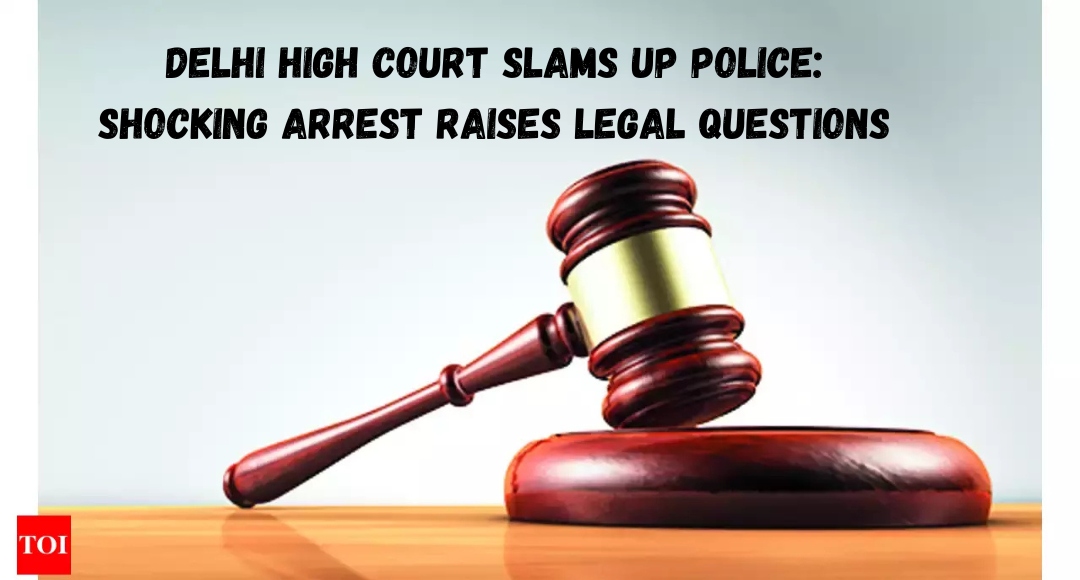Delhi High Court Slams: Imagine walking through the bustling streets of Connaught Place, going about your daily routine, when suddenly, you’re stopped and taken away by the police without any prior notice. This unsettling reality unfolded for a Delhi resident who was allegedly arrested by the Uttar Pradesh Police in the heart of the national capital, sparking outrage and legal scrutiny. The Delhi High Court has now stepped in, questioning the actions of the UP Police and demanding a detailed inquiry report into the incident.
Court Demands Accountability
The Delhi High Court, led by a bench of Justices Prathiba M Singh and Rajneesh Kumar Gupta, has taken the matter seriously, directing the Director General of Uttar Pradesh Police to submit a detailed report. The court’s order, made public on March 20, specifically instructed that the Commissioner or DGP of UP Police must file a status report, explaining why and how the arrest took place without following proper legal procedures.

This case revolves around a man, identified as Satinder Singh Bhasin, who was allegedly intercepted and taken away by UP Police from Delhi’s Connaught Place on February 18. Shockingly, there was no prior intimation to the Delhi Police about this arrest. After spending a night in custody, the petitioner was released by a UP court on February 19. However, the incident has now raised critical questions about whether inter-state police operations can bypass legal protocols so easily.
Violation of Legal Procedures?
The Delhi High Court has emphasized that inter-state arrests must follow proper procedures. In a previous hearing, the court had already instructed the Greater Noida Police Commissioner to submit a report regarding the arrest. Advocate Vishal Gosain, representing the petitioner, pointed out that his client was never summoned for questioning or asked to record a statement before being detained. The abrupt arrest, without any prior communication or legal notice, has been strongly contested in court. Adding another layer of complexity, a video clip surfaced, allegedly suggesting that the petitioner was misusing court orders in his habeas corpus petition. The court was quick to warn that no one should “misuse or misinterpret” judicial rulings for personal gains. The primary objective of the habeas corpus plea, the court stated, was to ensure the safety and security of the petitioner, not to settle individual disputes or seek publicity.
CCTV Footage Ordered to Be Preserved
To ensure transparency, the court has directed that CCTV footage of the arrest be preserved and presented before it. The incident has raised a major cause for concern, as the UP Police allegedly carried out an operation in Delhi without adhering to prescribed legal protocols. On February 20, the court sought a detailed response from both the UP and Delhi Police, demanding an explanation of how such an incident could occur in the national capital. Bhasin, who had appeared in court after his release, also alleged that he was physically assaulted and manhandled by the police. The Greater Noida Police Commissioner has been ordered to submit the petitioner’s medical report to determine whether he sustained any injuries in custody. Meanwhile, the UP Police counsel has defended the arrest, stating that an FIR was registered against Bhasin under the newly implemented Bhartiya Nyaya Sanhita for alleged offences related to theft in Greater Noida, Gautam Budh Nagar. However, how the arrest was conducted remains highly controversial.
A Matter of Public Concern
This case goes beyond just one person’s arrest—it raises bigger questions about the way law enforcement agencies operate across state borders. Can police from one state enter another and arrest someone without informing the local authorities? Does this set a dangerous precedent for law enforcement overreach? The Delhi High Court’s firm stance on this matter highlights the importance of protecting the legal rights of citizens while ensuring that law enforcement agencies follow due process.

As the case unfolds, all eyes will be on the UP Police’s response and the inquiry report that the court has demanded. The outcome of this case could set a significant legal precedent for inter-state police operations in the future.
Disclaimer: This article is based on publicly available information regarding a legal case and does not intend to make any judgments about the individuals or law enforcement agencies involved. Readers are encouraged to follow official legal proceedings for further updates.
Also Read:
Evolution and Scope of Administrative Law
What is Tort Law: Legal Concepts and Practical Examples
Supreme Court Slams Overpriced Lawyers: Justice Must Be Accessible to All






